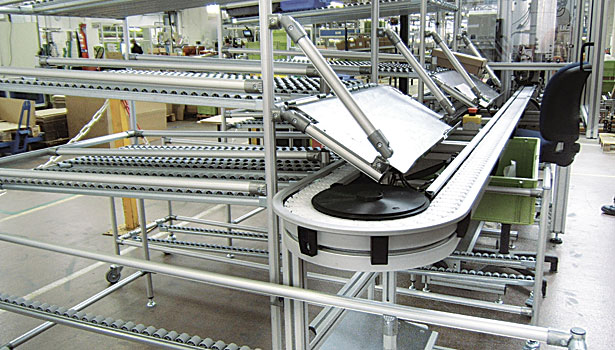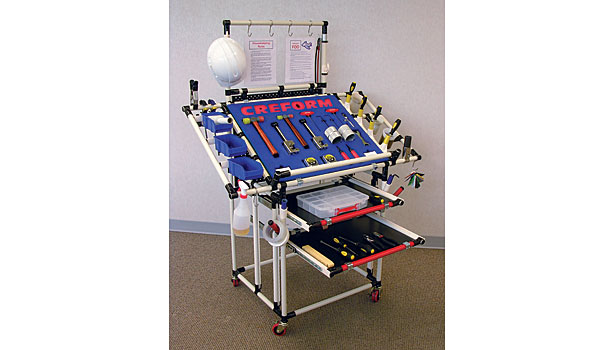Modular Framing Systems Let Engineers Get Creative
New products enable high levels of flexibility and customization.

Round tube framing is versatile, simple and efficient for building custom structures that require few components. Photo courtesy Bosch Rexroth Corp.

Modular profile systems enable assemblers to bolt together framing components to tailor workstations and machines to specific processes or floor space requirements. Photo courtesy Flex Craft LLC

Modular systems appeal to anyone who’s had childhood experience with toys such as Erector Sets, Legos or Lincoln Logs. Photo courtesy Creform Corp.

Modular aluminum framing is lightweight, easy to configure or modify, and requires no special tools to assemble. Photo courtesy Bosch Rexroth Corp.

Mobile display boards can be positioned close to the point where the information is needed. Photo courtesy Creform Corp.

The breadth of product offerings and solutions for modular systems has increased over the last 10 years. Photo courtesy Flex Craft LLC

Modular profiles can be used to create tool carts, kitting carts and other types of material handling equipment. Photo courtesy Creform Corp.







The widespread availability of modular profile systems has made it easy for engineers to get in touch with their creative side. They enable assemblers to bolt together framing components to tailor workstations and machines to specific processes or floor space requirements. Engineers can reconfigure assembly lines quickly and easily while minimizing capital outlay.
Modular fixturing and framing systems can be made of aluminum, plastic or composites. The systems are comprised of custom and standard parts that can easily be assembled and modified with hand tools. Unique joining methods allow for high levels of flexibility and customization in building workstations, flow racks, conveyors, material handling carts, fixtures, machine housings and other production equipment.
“Aluminum structural framing systems are infinitely adjustable, due to the T-slots or mounting features inherent to their design,” says Kurt Greissinger, vice president of Lean Factory America LLC, which markets products from Japan’s SUS Corp. “This allows for experimentation and ease of positioning or repositioning.
“A piece of equipment can be quickly built and put into production and fine-tuned based on user experiences,” Greissinger points out. “Accessories can be relocated from one side to another, and additional frames can be added or subtracted easily.”
“Modular systems support creativity so you can capitalize on the ingenuity of your associates,” adds Keith Soderlund, vice president of sales at Creform Corp. “That’s key to creating a competitive advantage.
“Anyone can just purchase a catalog structure, but then you either have to modify it to suit your needs or change the way you work to suit the standard structures,” argues Soderlund. “Competitive advantage comes from being unique and optimizing your process. You are limited only by your imagination.”
According to Soderlund, modular systems appeal to anyone who’s had childhood experience with toys such as Erector Sets, Legos or Lincoln Logs. “What you build with it is up to you,” he points out.
“This freedom can be intimidating to some people,” notes Soderlund. “But, when you think outside the box, modular systems can provide a means to an end. Having such a tool helps [people] harness their creativity and try out their ideas, since they know they can always take a structure apart and reduce it down to individual components.
“This flexibility extends over the life of the structure,” Soderlund points out. “The ability to easily move things around or add and delete something can be invaluable. Small changes and modifications can often be made quickly and easily while the structure remains in place.”
Myths and Misperceptions
While many engineers understand the benefit of modular automation components, several misperceptions persist. For instance, there’s a myth that framing systems cannot stand up to the demands of factory environments like welded steel can. However, recent advances have made them stronger and more vibration resistant.
“The biggest misperception is that these systems can’t be used under higher loads,” says Tyran Howe of MayTec Inc. “[In the past], some people had bad experiences with poorly designed connectors, so their base frame applications failed. Thinking that all profile systems are pretty much the same, they stay away from it and go back to steel instead of researching a system with higher load ratings.”
“Some [people] believe modular systems are not robust enough to handle the rigors of manufacturing, due to the friction-based joint used by [some suppliers],” says Jake Sparks, sales manager at Flex Craft LLC. “Advances in direct-bolt joints solve this problem and are capable of holding thousands of pounds. [In addition, some engineers] still don’t see the cost benefit of recycling old projects into new [creations] and would rather buy disposable catalog [items].”
The breadth of product offerings and solutions for modular systems has increased over the last 10 years. Suppliers now offer more profile shapes than ever, such as round tubes. There are also more opportunities to create aesthetically pleasing designs with closed, smooth-sided components.
“[Many of today’s creations] do not show any T-slots facing to the outside,” says Howe. “They also look much cleaner, because they are built with strong internal connectors that are not visible. Big connection plates and gussets are no longer dictating the look of the machine frames. A clean look is the target of today’s design.”
In addition, design software, such as MayCAD from MayTec and MTpro from Bosch Rexroth Corp., allows engineers to be more creative than ever.
“[Our 3D] configurator shows the cost while you are designing,” claims Howe. “The software creates a complete, correct bill of material with all part numbers, pricing and, most important, the correct machining codes for all profiles.”
Lean Applications
Traditionally, modular profile systems have been used by engineers to implement lean manufacturing initiatives.
Manufacturers with a high degree of manual assembly require flexible, ergonomic workstations with material shuttles and flow racks to quickly rearrange production and respond to customer demand. Modular aluminum framing can be used to easily create custom workstations, work carts and factory fixtures to help companies with their unique [production] processes.
Bosch Rexroth recently unveiled a line of round tubing called EcoShape that is versatile, simple and efficient. It enables easy connections between square and round framing components.
With EcoShape, you can build custom structures that require very few components. Planning is easy, too, thanks to the new MTpro planning software and the ability to make virtually any connection with a few standard parts. You can combine it with our rectangular framing to build heavy-duty bases for carts and flow racks, or just expand the system functionality.
Modular profile systems also allow engineers to address ergonomic issues and concerns. A few years ago, many production lines were focused to optimize the process, deliver quality and adapt to customer demand. What was often forgotten was the worker, who is the most integral part in manufacturing a quality product. Incorrect posture at the workplace can result in a waste of up to 40 percent of an employee’s potential output at work.
Cutting-edge lean manufacturing concepts, such as karakuri and minomi, are also generating new applications for aluminum framing systems.
“Karakuri” is a Japanese word that means producing work with little energy input. The energy-saving concept utilizes the flow of gravity to guide bins of parts and components forward, increasing efficiency and ergonomics.
“Ordinary forces, such as gravity, counterweights and springs, create extraordinary results that can minimize operator workload and improve ergonomic conditions,” says Greissinger. “A single pull of a lever or step on a foot pedal can put the system into motion to exchange an empty tote for a full one or stack boxes in a first-in, first-out manner.”
SUS recently unveiled a line of GreenFrame products that are fully recyclable and 40 percent lighter than traditional plastic resin-coated steel pipes. “The system enables karakuri, due to its design and accessories,” claims Greissinger.
“Products are continuously being developed to support karakuri initiatives,” explains Greissinger. “These include rotary connectors, linear slides, elevator locks and brake kits. In the past, customers had to fabricate all of these items at great expense to accomplish their objectives. Now, they are standard, off-the-shelf parts that save time and money.”
One thing that makes GreenFrame unique is its mounting feature. “Unlike round tubes where the only connection method is to clamp around it, GreenFrame connectors grip onto the face of the profile,” notes Greissinger.
“This ensures perpendicularity and parallelism when building, and allows for the same or different connectors to be populated around the tube at the same level,” says Greissinger. “The system also allows for single-bolt, one-touch construction that allows one person to easily build entire structures with simple hand tools.”
Another lean manufacturing concept that appeals to engineers is “minomi,” or “peanut without the shell.” It refers to a method in which parts are handled or flowed without containers, pallets or cartons. Minomi is especially useful in kitting operations.
“This [requires] a custom solution that suits a modular system well,” says Creform’s Soderlund. “Our Placon conveyor is often useful for such projects.”
The gravity conveyor system is supported by a wide selection of roller styles, frames and guide rails. “Three-inch wide rollers provide the stability and support necessary to handle minomi challenges,” says Soderlund.
“Precision rollers spin freely and smoothly on polished stainless steel axles requiring less flow-lane angle than conventional skatewheel conveyors,” Soderlund points out. “Each of the flow rack’s levels can be repositioned, or the entire mobile flow rack can be customized, with only simple tools. Wheels, supports and axle components are all modular, facilitating easy assembly and disassembly.”
Modular systems can also be used to create tool carts, kitting carts and other types of material handling equipment that support small batch runs with mixed-model synchronized production. Growing interest in automation has driven many manufacturers to invest in automated guided vehicle (AGV) systems. Several suppliers of modular profile systems have answered the call with inexpensive, bolt-on AGV tuggers that automate pipe- and frame-built carts.
For instance, at last month’s ASSEMBLY Show in Rosemont, IL, Worksmart Systems Inc. unveiled a “power cart” called Fleximate. The six-wheeled, height-adjustable device provides manufacturers a way to easily reconfigure assembly lines.
“Line rebalance is quick, [accomplished by] either moving a magnetic target or a simple reprogram,” claims Larry Sorgi, president of Worksmart Systems. “The goal is to provide a flexible, barrier-free assembly line.
“The Fleximate power cart complements modular workstations, flow racks and parts carts,” says Sorgi. “It is ideal for heavy assemblies, such as fuel rails and transmissions.”
Looking for a reprint of this article?
From high-res PDFs to custom plaques, order your copy today!











